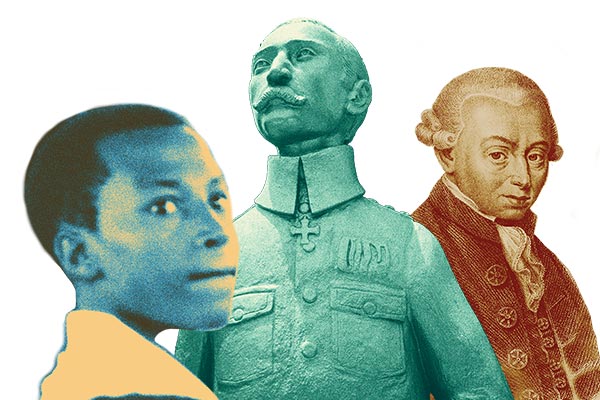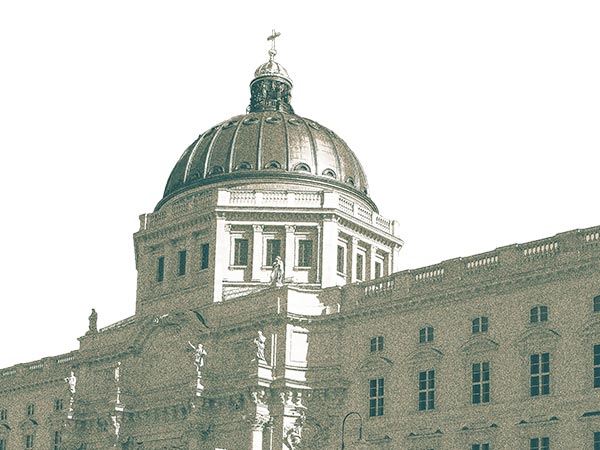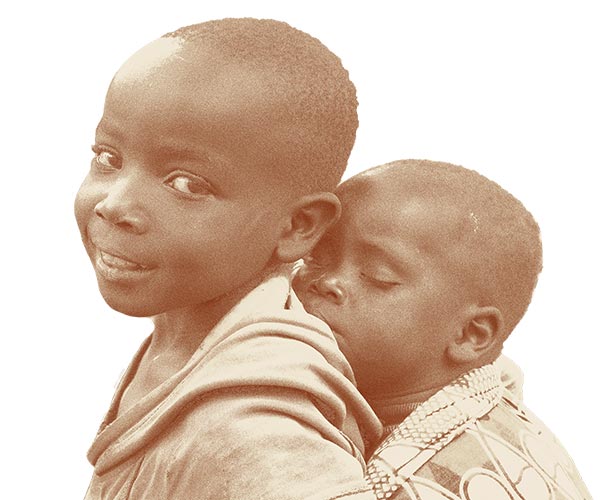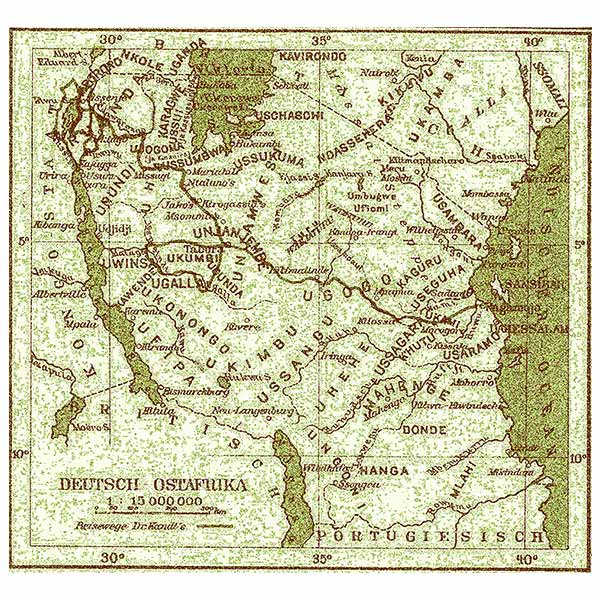Subtotal: $
Checkout-

The End of Rage
-

Telling a Tale of Two Fathers (Video)
-

Home Is Not Just a Place
-

The Quest for Home
-

In Search of Lost Fig Trees
-

Child of the Stars
-

Refugee Letters
-

Life in Zion
-

How to Run a Cemetery
-

Integrity and the Future of the Church
-

Daring to Follow the Call
-

Poem: “For the Celts”
-

Poem: “Wreathmaking”
-

Poem: “The Hunger Winter, 1944–5”
-

Editors’ Picks: The Cult of Smart
-

Editors’ Picks: The Utopians
-

Editors’ Picks: The Lincoln Highway
-

Casa de Paz
-

The Pilsdon Community
-

Letters from Readers
-

Nonexistence Does Not Scare Me
-

Toyohiko Kagawa
-

Covering the Cover: Beyond Borders
-

Choosing America
-

Church as Sanctuary and Shelter
-

Northern Ireland’s New Troubles
-

When Migrants Come Knocking
-

The Florentine Option

Three Kants and a Thousand Skulls
In Rwanda, the tales of a young student, an Enlightenment philosopher, and a skull-hunting colonialist intertwine.
By Simeon Wiehler
September 15, 2021
Available languages: Español
Next Article:
Explore Other Articles:
Some two years ago, after I gave a lecture on “building better societies,” I was followed back to my office by a student with the formidable name of Nkurikiyumukiza Kant. (In the Rwandan naming system both are first names, one being African and the other Christian, French, or something noteworthy – I know several Clintons, a Reagan, and many, many young Obamas.) Kant wished to discuss further an idea he had voiced in lecture: that Rwandans had treated each other with such cruelty during the genocide because they did not love animals. While it is true that nobody here keeps pets, and that one regularly encounters rank callousness toward animals in the fields or headed for the market, it is not the sadistic, vicious cruelty that was the hallmark of Rwanda’s 1994 genocide, but something closer to expedient insensitiveness, or an insufficiency of identification with the potential for suffering in other creatures.
I had skirted his proposition in lecture and Kant lost no time in bringing his famous namesake to bear him witness. Here it is, he said, jabbing his finger into a well-worn copy of Immanuel Kant’s Lectures on Ethics: “He who is cruel to animals becomes hard also in his dealings with men. We can judge the heart of a man by his treatment of animals.”
I knew Kant had come from a government-run rural high school near the bottom of the national rankings. Like the vast majority of my students he was the first in his family to attend university. As dean of the School of Social, Political and Administrative Sciences, I also knew that he was middle-of-the-pack in his university cohort. But he did stand out. He had an earnestness about him that showed fairly quickly that he wasn’t attending Rwanda’s premier tertiary institution for the social life. He really wanted to engage, to understand. Perhaps because of this he asked questions fearlessly.

Immanuel Kant (1724–1804); Richard Kandt (1867–1918); and an unidentified University of Rwanda student contemporary with Nkurikiyumukiza Kant, for whom no photograph could be found. Images public domain
In my travels across the continent I have encountered many like him: smart, inquisitive, soaking up knowledge like the red volcanic loam of Rwanda soaks up the first rain after the long dry season, but with family histories overflowing with suffering, dislocation, and deprivation: genocide trauma, refugee camp survival, war, and always – like background music – grinding poverty. How many African Albert Einsteins or Toni Morrisons, Nelson Mandelas or Immanuel Kants has our world never known because they dropped out of primary school to fetch firewood or pick coffee so their families could survive? They don’t disappear, of course. They live out their lives in their villages: the shopkeeper who can do complex multiplications instantaneously in his head, the farmer famous for the wedding poetry he creates and memorizes while herding his cows, the wise elder whose advice has soothed troubled marriages and ended village feuds. They know the value of education and try to send their children to school, but even those that reach their local high schools face major challenges. I have visited rural high schools that had received computers from the government but did not have electricity. In others, teachers were using computers for instruction with students carefully taking notes on which icon the teacher clicked. These rural students arrive at our university and tell me they “know” computers, but have never “used” one.
So it was that Kant arrived on campus, eager to learn and unshrinking when he had a question or wanted to raise a point. I got the impression this vexed other professors, but I enjoy classroom discussion and debate and was usually happy when Kant interrupted me in mid-sentence. Such teachable interludes often help students grapple with complex thoughts or big ideas, but his attempt to link the genocide with how Rwandans regard animals curved in from so far in left field that I stammered and brushed it aside with a wholly unsatisfactory non-answer.
I was reminded of Kant and his animals in the months before coronavirus became a household word, when I was asked to join a committee set up to advise on what to do with a thousand Rwandan skulls discovered in museum storage in Berlin. They had been collected by the German explorer, psychiatrist, and colonial governor Richard Kandt between 1901 and 1907 with the double goal of defining a “racial” difference between the Tutsi and Hutu populations of Rwanda and measuring cranial capacity to support the assertion that Europeans were smarter than Africans.
The skulls had been amassed in the governor’s mansion in Kigali from looted funeral locations all over the country, and from the national execution site near the palace of the traditional ruler, the Mukama, who continued to hold immense cultural sway even under colonialism. Kandt himself was an efficient administrator, a ruthless man with a prodigious appetite for assembling large collections pertaining to some of his more mordacious predilections: venomous snakes, lizards, poisonous spiders, crocodile skins, lion paws. Some of his collections are today on display in the very same mansion, recently converted into a museum. But his collection of skulls did not stay in Rwanda; they were shipped off to Berlin for “scientific” scrutiny, where they were eventually forgotten in storage. They survived catastrophic bombing in World War II and were rediscovered during the planning of the recently opened Humboldt Museum in Berlin, posing awkward questions about Germany’s racist and colonialist past, and presenting a diplomatic predicament for Rwandan-German relations.

The Humboldt Museum in Berlin Image public domain
Since the Rwandan genocide, the country has been struggling to deal with its much more recent legacy of horror and trauma. Mass graves or scattered bones are regularly uncovered during construction excavations or when a perpetrator decides to come clean, but no one had an inkling that any Rwandan bones were in Germany, let alone a thousand human skulls. When the message arrived from the Humboldt Museum organizers, suggesting that university professors from the social sciences should assist in the diplomatic deliberations, I was asked to join the discussions.
My path to Rwanda was an unusual one in the first place: I grew up in the Bruderhof communities in Pennsylvania and England. In my late teens, with no idea what I wanted to do with my life, I took a job outside the community that led me eventually to help in a Ugandan organization assisting street children. It was 1982. One year grew to thirteen, which encompassed a civil war and two coups, some successes and many failures, friends good and false, happy moments and lonely despair. I learned what fear was, and rank injustice, that children laugh and sing and play even amid deep poverty. And I learned about death. Lots of death.
I picked up the language and slowly grew into the culture – how disorienting and different it was from the Bruderhof, or indeed from Western culture, but how, once one looked from the inside, it was logical and made its own sense of the world and of foreigners like me. Woven through all this were the street children who became my Ugandan family. Most had suffered terribly in the war, lost their families, fled their villages, and ended up in Kampala’s markets, municipal dumps, and street margins. It gave me profound joy to see many of them shape those broken and painful pieces into new lives. I worked on ways that seemed to help this process and slowly evolved ambitious national plans to solve the street-children problem in its entirety, which I pushed with all involved. A healthy society, I kept repeating, will never tolerate hundreds of children begging from motorists, stealing in the markets, and sleeping on the verandas of the city.
At the time the war ended in 1986, I assumed street-child numbers in Kampala would decrease, but over the following years they increased rapidly. This conundrum, and the inability of NGO colleagues, government demographers, and a growing circle of academics to answer it, eventually led me to study this issue at Cornell University, which offered me access to knowledge and research that in those pre-internet days was impossible to obtain in Uganda. (Cornell also gave me a scholarship.) I wanted to know what strategies other countries had adopted – New York City had a huge street-child population, as did London. What did they do to address this?

Photograph by Adam Cohn (public domain)
Later, doing a Fulbright-funded Africa-wide comparison of street-child programs, I met my wife-to-be in Rwanda, running a vocational training center. We were married in 2003, and when I finally finished my PhD, a teaching position opened up at the University of Rwanda – a perfect fit.
Rwanda has adopted almost the entire multipronged street-child solution I had been proposing. This included implementing universal primary education, with truancy enforcement; mandating parental responsibility for minors; banning child labor; buttressing the country’s universal health insurance; setting up intervention centers; and deploying a nationwide team of social workers both to monitor the streets and to supervise family reintegration programs. All this, of course, has required long-term policy and budget commitments at the national level. But the effects have been dramatic. Today Rwanda is the only country in Africa in which you will not find children sleeping on the streets. All is not perfect, of course – no bureaucracy is – and Covid-19 has put additional stress on the system. But by and large it works. These days I teach and try to inspire Rwanda’s brightest young future leaders, helping them think of better ways to solve social problems, think strategically about social change, and imagine better societies (in which there are, of course, no street children).
But back to those skulls.
Everyone in our meetings agreed that the skulls must be brought back and respectfully interred in Rwandan soil, but engaging the nation in welcoming these remains, taken in such a different era, raises complex cultural, historical, emotional, and religious issues. How would one explain to a national audience the early-twentieth-century fascination with the pseudosciences of craniometry, phrenology, or race-intelligence hierarchies? How account for the arrogant cruelty of European colonial rule, in which a governor could amass human skulls as if they were a stamp collection?
In our meetings we discussed whether these skulls might be DNA-linked to a near relative or family, but without nationwide DNA data this is unlikely. What kind of welcoming ceremony would be appropriate? What about burial observances? When these skulls were collected, Christian missionaries had not made any converts in the country. The indigenous religion had not been entirely animist; the Great God, Imana, was said to spend his days traveling around the world, but at night always returned to Rwanda. But within this belief system the bones of the dead were – like clothing or the cowhide sandals everyone wore – considered the cast-off leftovers of life. The spirits of the dead were not connected to the bones but housed in tiny thatched huts behind each family dwelling; food and alcohol were offered to keep them happy (an unhappy spirit would surely cause problems). Westerners, for whom human bones hold, even in death, something of the essence of the person who once animated them, could consider this: We discard cut hair and fingernail clippings because, once cut, we perceive them as possessing no human essence. In many traditional African cultures if a strand of hair or a single nail-clipping lands in the wrong hands it can be a powerful means for wreaking havoc upon its erstwhile owner. Hair and fingernails were imbued with life-power; bones not so much.
Truly opposing genocide or colonialism, racism or discrimination does not start from moral superiority but through deep humility.
Much of this age-old culture has changed. In the course of less than two generations, the god of the occupier replaced local gods. Ancient traditions and belief systems morphed into dispositions acceptable to a powerful colonial church and coercive governing elites. This trend continued in the years following independence. Rwanda today is highly Christianized; about 95 percent self-identify as Christian. And yet in the moment of national trauma, Rwandan Christians failed to stand up for love, mercy, and tolerance, or even basic humanity. During the three months of genocide in 1994, Christians of all denominations filed out of church on Sunday mornings to slaughter their neighbors. Pastors organized the mass murder of their parishioners. Priests killed fellow priests. Nuns decapitated orphans. Bishops bulldozed churches where fleeing Tutsis had sought refuge. All on the basis of a social division which had come to represent access to power, privilege, and status. The failure of Christians (except in a tiny number of isolated cases) to stand up to the Hutu-Tutsi social divide remains an indictment of a century’s worth of missionary endeavor in this part of the world.
In our meetings about the skulls we explored how to frame a national discussion around colonial barbarity and genocidal brutality, both examples of humankind’s predilection for hatred and immeasurable cruelty. The conversation has become an opportunity to imagine a way out of hell. Maybe Kant’s “treatment of animals” does have something to say, not because animal life is to be valued as human life, but because our attitude in this regard holds a mirror to our deepest selves, shows us the truth of our moral shallowness, the gap between our ideals and our actions.

Map showing the route of Richard Kandt’s expedition, 1897–1901 Image public domain
But there is something more. Governor Kandt dehumanized Africans, treating Rwandans as mere animals whose skulls could be collected. Genocide dehumanized Tutsis; the extremist radio called them “cockroaches” and screamed for these “vermin” to be exterminated. In both historical instances we confront the stripping of the sacredness from fragile humanity, humans equated to animals to be butchered or collected. But dare we peer into this abyss without also confronting the same propensity in our own hearts, the inclination towards evil, where we have marginalized, belittled, undervalued, or hurt others whose lives are equally precious in God’s eyes? Truly opposing genocide or colonialism, racism or discrimination does not start from moral superiority but through deep humility that sees fallen humanity with all its failings, and recognizes that human fallenness in our own hearts as well.
Only then can we ask ourselves if we are the systemic change that this world needs. Do we embody a shared willingness to contribute to the common good to achieve what the individual alone cannot? Are we truth-seekers? Telling the deep truth about ourselves, about our comfortable myths and imagined realities can be uncomfortable, but without truth-seeking, good cannot grow and evil clings on, like mold, in the cracks. Have we looked at the world around us and imagined what might be better and then said so? Do the small acts of our daily lives help build stronger relationships, better neighborhoods? Do our actions strengthen justice and enhance what is good in our communities? Do we pursue peace and oppose hate even in the small things, knowing that small plus small plus small can get pretty big? Will each one of us be able to say, when life nears its end, that we planted our feet determinedly on the side of good, that we struggled for what was right, that we joined with similarly-minded people and together tried to build a better society?
As we attempted to come to terms with the layered meanings of those thousand skulls, a virus was spreading in Wuhan, China, which would soon close down the university, strangle the economy, confine us in our homes for weeks at a time, and postpone all our decisions to some later date. What a humbling reminder of all we do not control on this small planet of ours.
I had one more interaction with my student Kant, who tugged at my arm in the hallway one day, just before the pandemic struck. He wanted to discuss his latest quote from the other Kant (or at least attributed to him): “We are not made rich by what we possess but by what we can do without.” I told him I approved the sentiment – I was thinking, “that’s very Bruderhof” – and suggested he drop by sometime for a discussion. It was not to be. A few days later he was killed in a bus accident on the treacherous mountain roads near Karongi, along with twenty-six other passengers.
At such times one feels oneself encircled by death: the death of a smart and inquisitive student, a million genocide deaths, a thousand skulls in a faraway land. But face it livingly we must: we actively engage in the inch-by-inch remaking of a post-genocide nation; we encourage young students to imagine better societies. We negotiate the repatriation of stolen human remains, because we have peered into the abyss of human depravity, glimpsed the outlines of consummate evil, and determined that in our own lives and in the lives we touch, we must stand for something diametrically opposite.
In this lies the measure: that our respect for life finds reflection in our treatment of all God’s creatures, not least our human brothers and sisters; that we love our neighbor as ourselves, and do not return evil for evil, but lean toward all that is good. Or, as my student Nkurikiyumukiza Kant wrote in last year’s exam, about how he intended to be part of building a better society: “Go into the world as peacemakers. Be courageous for what is good. Do bad to nobody. Help the weak and the poor. Treat each other with respect,” he wrote, with a final evocation of his namesake’s “starry skies above and the moral law within.” I miss him.
Already a subscriber? Sign in
Try 3 months of unlimited access. Start your FREE TRIAL today. Cancel anytime.








































Mary Kressin
This article really touched me. Thank you for listening to this young man, and keeping him alive in your writing .
John Steward
The call for earnest self-examination, as the way to find the humility, without which I also remain a dehumanizer. I have never found this quality more clearly to be seen than in many of my Rwandan friends, some of whom suffered terribly and knew how colonialism played a role. My struggle is: how does the comfortable engage with such uncomfortable calls to reality? Has Covid levelled the landscape in a humbling way? May it be so in me.
Darryl Willis
It is a beautiful article, indeed. Thank you.
Catherine W Minnery
A beautiful piece. I especially appreciate it since I was in Rwanda in 2002. It was a short visit but remains with me to this day after months and months of soul searching because of the people I met and the stories I was told. I feel the loss of your wise student.
Burl Self
Great article with great spiritual insight. Thanks
Rev. Dr. James B. Vigen
A very beautiful and moving article. Thank you for that. And thank you for sharing the memory of Nkurikiyumukiza Kant. Rev. Dr. James B. Vigen +